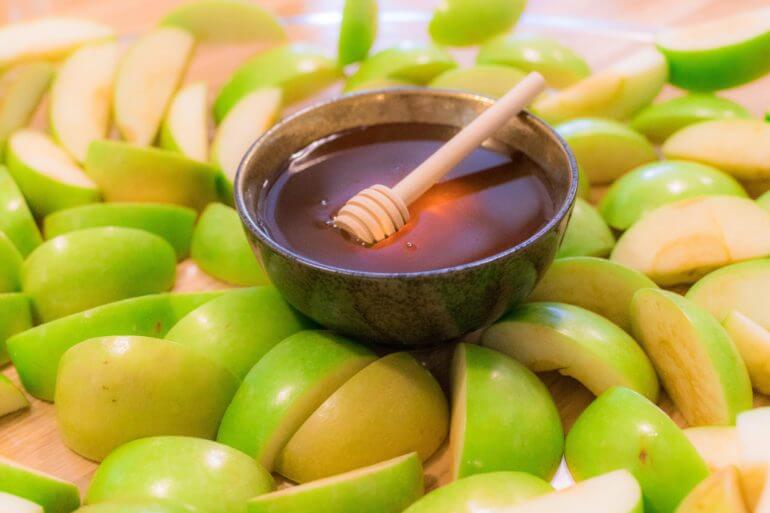
What is the Connection Between the Rosh Hashana Segulot and Eating Those Foods?
Dear Jew in the City,
What is the connection between the Rosh Hashana segulot and eating those foods? Does eating them really do anything or is it symbolic?
Sincerely,
David
Dear David,
Oh, boy. This is one of those posts that isn’t going to be very popular with some people.
For those who are unaware, we eat certain foods on Rosh Hashana night as a sign for good things during the year. These foods include the apple in honey (for a sweet year), a fish head, carrots and more. (You can read all about them here.) These are called the simanim (“signs”) and they are a segulah for a good year. (We’ll explain what a segulah is in a moment.)
The reason some people may not like this post is because there are those who take a very mystical approach to Judaism, while others are more rationalist. These two schools of thought will differ as to the nature of segulos. Since I belong to the rationalist school of thought, those of a more mystical bend may disagree with my approach. So, I’ll try to address the mystical side of things, but I may not be able to do it as much justice as someone from that side of the aisle.
Now let’s explain what segulos are. A segulah is some activity that people undertake in an attempt to change their “mazel” (in this sense, meaning “fate”). It could be eating certain foods on Rosh Hashana, reciting a certain Torah portion on a certain day, opening the ark in shul when one’s wife is in her ninth month of pregnancy, or even baking a key into a challah for the Shabbos following Passover. Some segulos go back at least to Talmudic times, while others are fairly recent innovations. (“Recent” can mean several hundred years – it’s a relative scale.) Some people believe that segulos are above nature.
In the classic work of Jewish thought Derech Hashem, the Ramchal (Rabbi Moshe Chaim Luzzatto – 18th century, Italy) explains that the physical world and the spiritual world are linked, with everything in our world having a spiritual counterpart. What happens to one affects the other, so sometimes we can do things here to increase the odds of desired results there.
The Rashba (Rabbi Shlomo ben Avraham ibn Aderet – 13th century, Spain) compared segulos to magnets. Seven centuries before Insane Clown Posse, he admitted to not understanding how magnets work, but he also acknowledged that, nevertheless, they did. According to this point of view, segulos are somehow natural, we just don’t understand how.
But there are segulos and then there are segulos, and people have different ideas in mind when performing those segulos. For one person, a segulah might bring him closer to God; another person might be acting superstitiously; for a third person, it might be bordering on idolatry.
There’s one particular segulah that illustrates this point quite well, and it dates all the way back to Torah times. In Numbers chapter 21, God commanded Moshe to make a copper snake and to raise it on a pole. If the Jews were bitten by venomous serpents, they would look at this effigy and be healed. Rashi cites the Mishnah (Rosh Hashana 3:8), which asks (rhetorically) whether a metal figure of a snake on a pole has the ability to cure people. Of course it doesn’t! Rather, the idea was that when the people looked at it, they turned their hearts to God, Who then healed them. If they didn’t have the proper intentions, however, they would die of their snake bites.
However, the story of the copper snake has an epilogue. In 2 Kings chapter 18, King Chizkiyahu destroyed the snake that Moshe had made because some people were offering incense to it. According to the Mishnah (Pesachim 4:9), the Sages approved of this action.
So here we have a segulah that God commanded Moshe, and that we know worked. Nevertheless, the Sages approved of its abolition because people were no longer using it as a means to direct their hearts to God, which is the whole purpose of a segulah.
The Steipler Gaon (Rav Yaakov Yisroel Kanievsky, d. 1985) wrote that one must avoid segulos that don’t have their basis in a Torah source (Karyana d’Igarta III, 1). There are plenty of such segulos. For example, honoring our parents is a segulah for a long life (Exodus 20:12). Honoring Torah scholars is a segulah that one’s children will be scholars (Talmud Shabbos 23b). Bentching with concentration is a segulah for one’s livelihood (Mishnah Brurah 185:1).
In researching this topic, I came across a piece by Rabbi Natan Slifkin, who credits Rabbi Dovid Landesman, who credits an anonymous source. The original (anonymous) source lists “time-tested segulot straight from the pages of the Torah, Talmud and rishonim.” I have selected just a few of my favorites. These include:
- Segulah for recovery from illness – go to a doctor (Talmud Brachos 60a);
- Segulah for longevity – lead a healthy lifestyle (Rambam, Hilchos Deios 4:20);
- Segulah for children – daven (Shmuel I 1, et al.);
- Segulah for livelihood – learn a profession (Kiddushin 30a);
- Segulah for faith – don’t believe in segulos (Devarim 18:13).
Most segulos are harmless, so go right ahead. The danger comes when we think that the segulah magically changes our fates. Eat your beets, carrots and fish heads on Rosh Hashana night, but don’t imagine that you’re Hermione Granger wielding the polyjuice potion. Remember that the quality of our years will be determined by our relationships with Hashem. Like Moshe’s copper snake, the simanim are intended to focus our attention towards God. If the simanim (or any other segulos) become the focus rather than the medium, then we’ve lost our way and have to reorient ourselves.
Shana tova!
Rabbi Jack Abramowitz
Educational Correspondent
Follow Ask Rabbi Jack on YouTube
If you found this content meaningful and want to help further our mission through our Keter, Makom, and Tikun branches, please consider becoming a Change Maker today.







